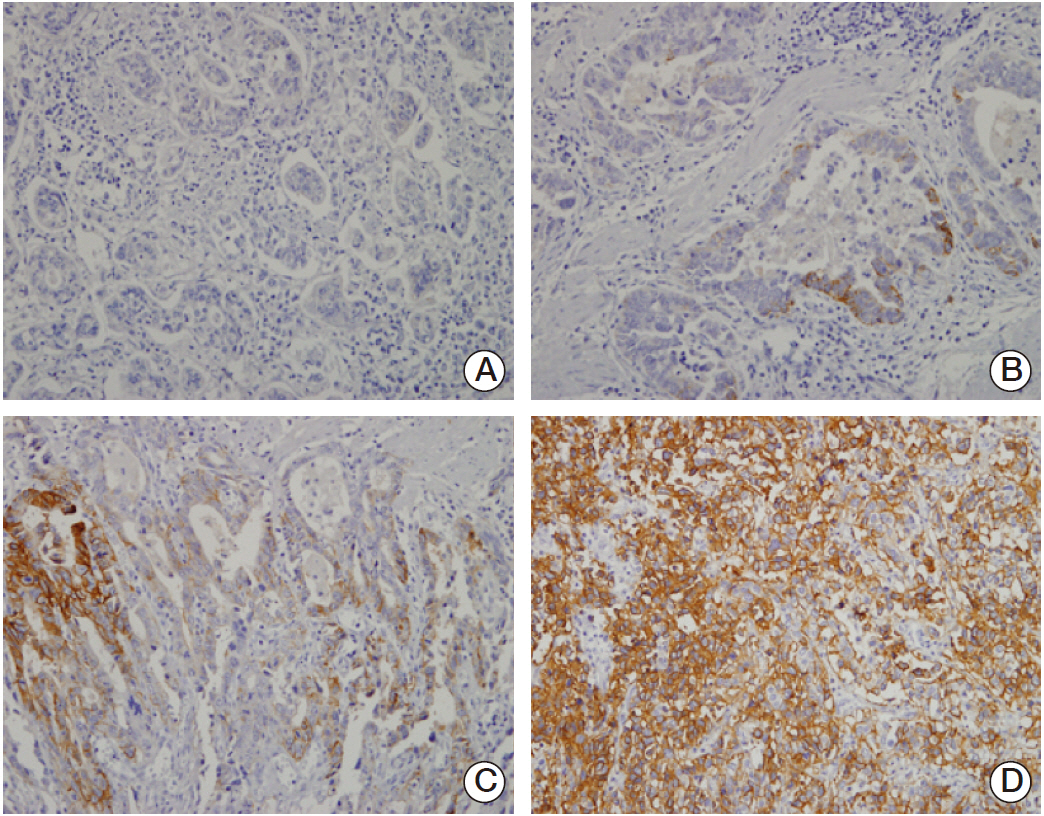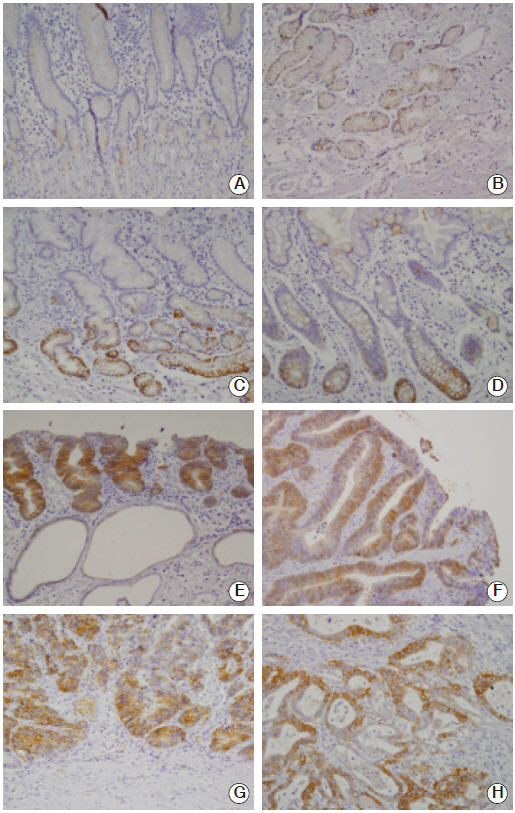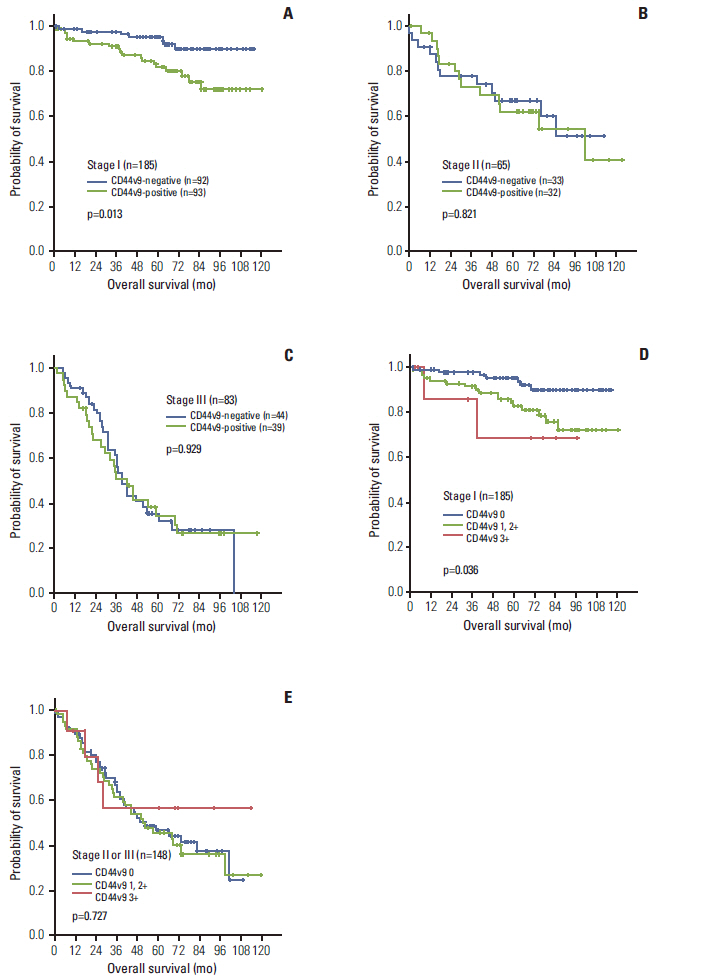Cancer Res Treat.
2016 Jan;48(1):142-152. 10.4143/crt.2014.227.
CD44 Variant 9 Serves as a Poor Prognostic Marker in Early Gastric Cancer, But Not in Advanced Gastric Cancer
- Affiliations
-
- 1Department of Internal Medicine, Institute of Health Sciences, Gyeongsang National University School of Medicine, Jinju, Korea. lwshmo@hanmail.net
- 2Department of Pathology, Institute of Health Sciences, Gyeongsang National University School of Medicine, Jinju, Korea.
- 3Department of Preventive Medicine and Environmental Health Center, Dong-A University College of Medicine, Busan, Korea.
- 4Department of Surgery, Institute of Health Sciences, Gyeongsang National University School of Medicine, Jinju, Korea.
- KMID: 2152270
- DOI: http://doi.org/10.4143/crt.2014.227
Abstract
- PURPOSE
The present study is to investigate the significance of CD44 variant 9 (CD44v9) expression as a biomarker in primary gastric cancer.
MATERIALS AND METHODS
With various gastric tissues, we performed immunohistochemical staining for CD44v9.
RESULTS
The positive expression rates for CD44v9 in tumor, including adenoma, early gastric cancer (EGC), and advanced gastric cancer (AGC), were higher than those in non-tumor tissues (p=0.003). In addition, the higher expression for CD44v9 was observed as the tissue becomes malignant. In the analysis of 333 gastric cancer tissues, we found that positive expression rates for CD44v9 were higher in the intestinal type or well differentiated gastric cancer than in the diffuse type or poorly differentiated gastric cancer. Interestingly, the positive expression indicated poor prognosis in EGC (5-year survival rate [5-YSR] in stage I, 81.7% vs. 95.2%; p=0.013), but not in AGC (5-YSR in stage II, 66.9% vs. 62.2%; p=0.821; 5-YSR in stage III, 34.5% vs. 32.0%; p=0.929). Moreover, strong positive expression (3+) showed a trend suggesting worse prognosis only in EGC, and it appeared to be associated with lymph node metastasis.
CONCLUSION
This study suggests that CD44v9 may be a good biomarker for prognosis prediction and for chemoprevention or biomarker-driven therapies only for EGC.
Keyword
MeSH Terms
Figure
Cited by 1 articles
-
The Use of CD44 Variant 9 and Ki-67 Combination Can Predicts Prognosis Better Than Their Single Use in Early Gastric Cancer
Se-Il Go, Gyung Hyuck Ko, Won Sup Lee, Jeong-Hee Lee, Sang-Ho Jeong, Young-Joon Lee, Soon Chan Hong, Woo Song Ha
Cancer Res Treat. 2019;51(4):1411-1419. doi: 10.4143/crt.2018.663.
Reference
-
References
1. Jung KW, Won YJ, Kong HJ, Oh CM, Lee DH, Lee JS. Cancer statistics in Korea: incidence, mortality, survival, and prevalence in 2011. Cancer Res Treat. 2014; 46:109–23.
Article2. Bang YJ, Van Cutsem E, Feyereislova A, Chung HC, Shen L, Sawaki A, et al. Trastuzumab in combination with chemotherapy versus chemotherapy alone for treatment of HER2-positive advanced gastric or gastro-oesophageal junction cancer (ToGA): a phase 3, open-label, randomised controlled trial. Lancet. 2010; 376:687–97.
Article3. Aruffo A, Stamenkovic I, Melnick M, Underhill CB, Seed B. CD44 is the principal cell surface receptor for hyaluronate. Cell. 1990; 61:1303–13.
Article4. Culty M, Miyake K, Kincade PW, Sikorski E, Butcher EC, Underhill C. The hyaluronate receptor is a member of the CD44 (H-CAM) family of cell surface glycoproteins. J Cell Biol. 1990; 111(6 Pt 1):2765–74.5. Thomas L, Byers HR, Vink J, Stamenkovic I. CD44H regulates tumor cell migration on hyaluronate-coated substrate. J Cell Biol. 1992; 118:971–7.
Article6. Gunthert U, Hofmann M, Rudy W, Reber S, Zoller M, Haussmann I, et al. A new variant of glycoprotein CD44 confers metastatic potential to rat carcinoma cells. Cell. 1991; 65:13–24.
Article7. Dalerba P, Dylla SJ, Park IK, Liu R, Wang X, Cho RW, et al. Phenotypic characterization of human colorectal cancer stem cells. Proc Natl Acad Sci U S A. 2007; 104:10158–63.
Article8. Ishimoto T, Oshima H, Oshima M, Kai K, Torii R, Masuko T, et al. CD44+ slow-cycling tumor cell expansion is triggered by cooperative actions of Wnt and prostaglandin E2 in gastric tumorigenesis. Cancer Sci. 2010; 101:673–8.9. Ishimoto T, Nagano O, Yae T, Tamada M, Motohara T, Oshima H, et al. CD44 variant regulates redox status in cancer cells by stabilizing the xCT subunit of system xc(-) and thereby promotes tumor growth. Cancer Cell. 2011; 19:387–400.
Article10. Yasui W, Kudo Y, Naka K, Fujimoto J, Ue T, Yokozaki H, et al. Expression of CD44 containing variant exon 9 (CD44v9) in gastric adenomas and adenocarcinomas: relation to the proliferation and progression. Int J Oncol. 1998; 12:1253–8.
Article11. Yamaguchi A, Urano T, Goi T, Saito M, Takeuchi K, Hirose K, et al. Expression of a CD44 variant containing exons 8 to 10 is a useful independent factor for the prediction of prognosis in colorectal cancer patients. J Clin Oncol. 1996; 14:1122–7.
Article12. Hirata K, Suzuki H, Imaeda H, Matsuzaki J, Tsugawa H, Nagano O, et al. CD44 variant 9 expression in primary early gastric cancer as a predictive marker for recurrence. Br J Cancer. 2013; 109:379–86.
Article13. Yamamichi K, Uehara Y, Kitamura N, Nakane Y, Hioki K. Increased expression of CD44v6 mRNA significantly correlates with distant metastasis and poor prognosis in gastric cancer. Int J Cancer. 1998; 79:256–62.
Article14. Yamaguchi A, Goi T, Yu J, Hirono Y, Ishida M, Iida A, et al. Expression of CD44v6 in advanced gastric cancer and its relationship to hematogenous metastasis and long-term prognosis. J Surg Oncol. 2002; 79:230–5.
Article15. Mulder JW, Kruyt PM, Sewnath M, Oosting J, Seldenrijk CA, Weidema WF, et al. Colorectal cancer prognosis and expression of exon-v6-containing CD44 proteins. Lancet. 1994; 344:1470–2.
Article16. Kim YS, Chi SG, Kim YW, Park YK, Yoon C. Molecular genetic characterization of alternatively spliced CD44 transcripts in human stomach carcinoma. J Korean Med Sci. 1997; 12:505–13.
Article17. Muller W, Schneiders A, Heider KH, Meier S, Hommel G, Gabbert HE. Expression and prognostic value of the CD44 splicing variants v5 and v6 in gastric cancer. J Pathol. 1997; 183:222–7.
- Full Text Links
- Actions
-
Cited
- CITED
-
- Close
- Share
- Similar articles
-
- The Clinical Value of CD44 in Gastric Cancer
- The Serum Assay of Soluble CD44 Standard, CD44 Variant 5, and CD44 Variant 6 in Patients with Gastric Cancer
- Tumor Size as a Prognostic Factor in Gastric Cancer Patient
- CD44 and CD133 as Cancer Stem Cell Markers for Gastric Cancer
- Expression of CD44 Variant 6 (V6) in endometrial cancer, endometrial hyperplasia, and normal endometrium








